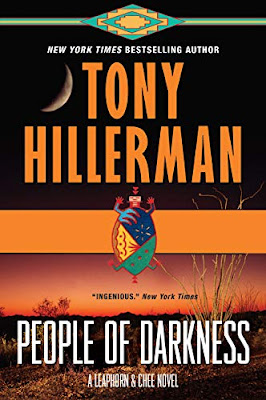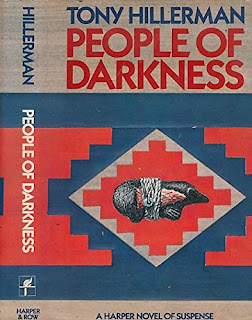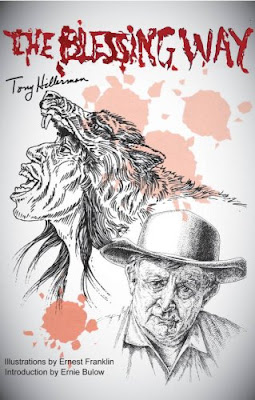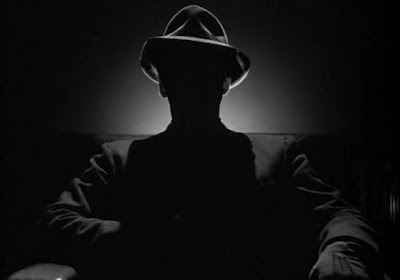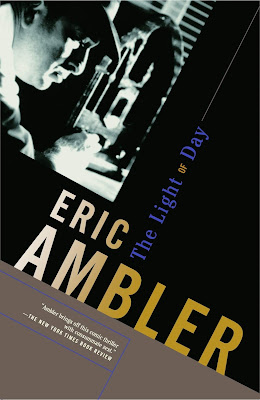Of
even more interest to me than the Navajo origin myths, which comprise
the heart and soul of Tony Hillerman’s Navajo Tribal Police mystery
series, are the stories of how he created its two main characters:
Lt. Joe Leaphorn and Officer Jim Chee. For the myths, Hillerman’s
research included heavy reading and personal immersion into the
Navajo culture, interviewing tribal elders and attending sacred
ceremonies. My research was much easier. I simply read the author’s
tell-all memoir, Seldom Disappointed.
Last
Friday’s report was on the series debut, The Blessing Way
which Leaphorn entered as an afterthought. Four books later, Chee
made his entrance, reducing Leaphorn to just a name (albeit with a
one-book promotion to captain) in People
of Darkness.
Hillerman
had intended to use Navajos only as minor characters. Relying on his
long experience as a news writer, his primary emphasis would be on
setting. “If the actors and the story line were weak, maybe I could
make the stage scenery so interesting it would carry the book.” The
lead character in Blessing
is
an anthropology professor studying Navajo culture. When the professor
needs information from a Navajo friend, Hillerman gives him Joe
Leaphorn, a tribal policeman. At this point, the author realized he
needed to know more about the Navajo people in order to give Leaphorn
credibility. “Making him seem genuine forced me to admit I didn’t
know nearly as much as I should about the Dineh.
“I
talked to Navajo friends, discovered I didn’t even know enough to
ask intelligent questions, and began endless hours of reading.
Reading everything: various versions of the creation myth, of curing
ceremonials, of witchcraft beliefs, clan structures, sand painting,
social life, sexual beliefs, taboos, puberty ceremonials, place
names, hogan building, etc. I read Ph.D. dissertations, proceedings
of dignified and scholarly societies, collected papers of the Peabody
Museum, the autobiography of Son of Old Man Hat, the accounts of
River Junction Charley, and on and on and on. Now I was ready to
interrogate Navajos. And the Navajos I asked were ready to recognize
that I was motivated by something more than idle curiosity.”
The
professor remains the central character, but Leaphorn’s is a strong
supporting role—so strong he’s promoted from officer to
lieutenant and takes the lead in the next two novels. And in the
process he teaches Hillerman a costly lesson. Excited by a film
company’s interest in the second book, Dance
Hall of the Dead,
he signed a contract giving the producer TV rights to the Leaphorn
character. The movie was never made, but Hillerman’s star was now
“held hostage.” Years later, when Robert Redford approached him
about making movies of three novels, Hillerman had to pay to break
the contract. He confesses in Seldom
Disappointed,
“Ransoming this figment of my imagination cost me twenty thousand
dollars and earned me a place in Guinness Book of Records if it ever
lists classic stupidities.”
Chee
already had joined the People
of Darkness
cast by the time Redford came along. Hillerman created him, partly
for artistic reasons, he said, “but also because my fondness for
Joe Leaphorn was undermined by the knowledge that I only owned part
of him, having signed away TV rights.” Perhaps Leaphorn’s
one-book promotion to captain was an unconscious gratuity for being
shunted aside—Hillerman never mentioned it--but he did admit to the
occasional error:
“Alas, my books tend to be noted for glitches, where I have
characters drive south when I meant north, for example, or change the
name of characters in the middle of a chapter, etc.” Going with
“glitch” as the more comfortable explanation, Leaphorn is back on
stage in the next episode, The
Dark Wind,
where he remains thereafter with his proper rank, co-starring as
Chee’s superior up to and beyond active duty into venerable
retirement where he becomes, as Chee likes to needle him, “The
Legendary Lt. Leaphorn.”
But
it’s all Chee in People
of Darkness.
We meet him as a sergeant, which I had forgotten from my first
reading of the series nearly four decades ago. As I recall, and as my
recollection was refreshed this time, rank doesn’t come into play
much with Chee—even when he did a stint as “acting lieutenant”
in a later novel. Besides introducing Chee in People,
Hillerman brought in another new character, but just for this outing.
Its unusually complicated plot, which “proved terribly tough to
keep...from being as boring to read as it was to write,” prompted
him to try something “the bona fide masters of suspense were doing.
First I had to have a professional hit man— a species I have never
believed in.” To add authenticity to this character Hillerman drew
on a death-row interview he’d conducted as a journalist. Far as I’m
concerned his fictional killer is as authentic as anyone I would ever
wish to encounter in the real. This addition to the “boring” plot
that has Chee methodically trying to find survivors of a long-ago
oil-well explosion, along with a perky young, blue-eyed single
schoolteacher who joins Chee on the search, ramps the story up to a
suspense level well worthy of those “bona fide masters” whose
success had inspired him.
With
the ingenuity of a magpie building its nest, Hillerman made use of
odd idea scraps he picked up along the way, such as his detailed
description of the three WWII medals—a Purple Heart, the Bronze
Star, and the Silver Star—found in the mysterious “keepsakes”
box of a character. Hillerman had received all three himself in that
war.
His
research for People
led to a joint venture with his “big brother,” Barney, a
geologist who specialized in analyzing core samples at oil-drilling
sites. On a visit to a site in Texas, where Hillerman kept an eye out
for plot ideas, the two cooked up the idea that led to the successful
photo book they called Hillerman
Country.
Barney had been thinking of leaving his nomadic life chasing oil
wells and turning his photography hobby into a career. Their mother’s
health had begun failing, and Barney, still a bachelor, decided to
build a house to share with her. Some years later, with Barney now
married and with three adopted children, the two brothers decided to
tackle the project they’d talked about, to try to capture in words
and pictures the Four Corners country that provides the distinctive
background for Hillerman’s Navajo Tribal Police novels.
In
one of the several boxes of books and sentimental keepsakes I have
yet to unpack from a couple of moves ago, rests my strikingly
beautiful, coffee-table-size, clothbound copy of Hillerman
Country,
which, thoroughly hooked on the mystery series by then, I’d bought
when it came out in 1991. Hillerman adds a characteristically
self-deflating note to the story, this one with a sad twist.
“The
experience taught me that, published author or not, one’s role as
Little Brother lasts as long as life,” he confessed in Seldom
Disappointed.
“Before [Barney] had a chance to notice that the reviewers were
more impressed with his landscapes than with my text, he had a sudden
and fatal heart attack while shooting another assignment.”
